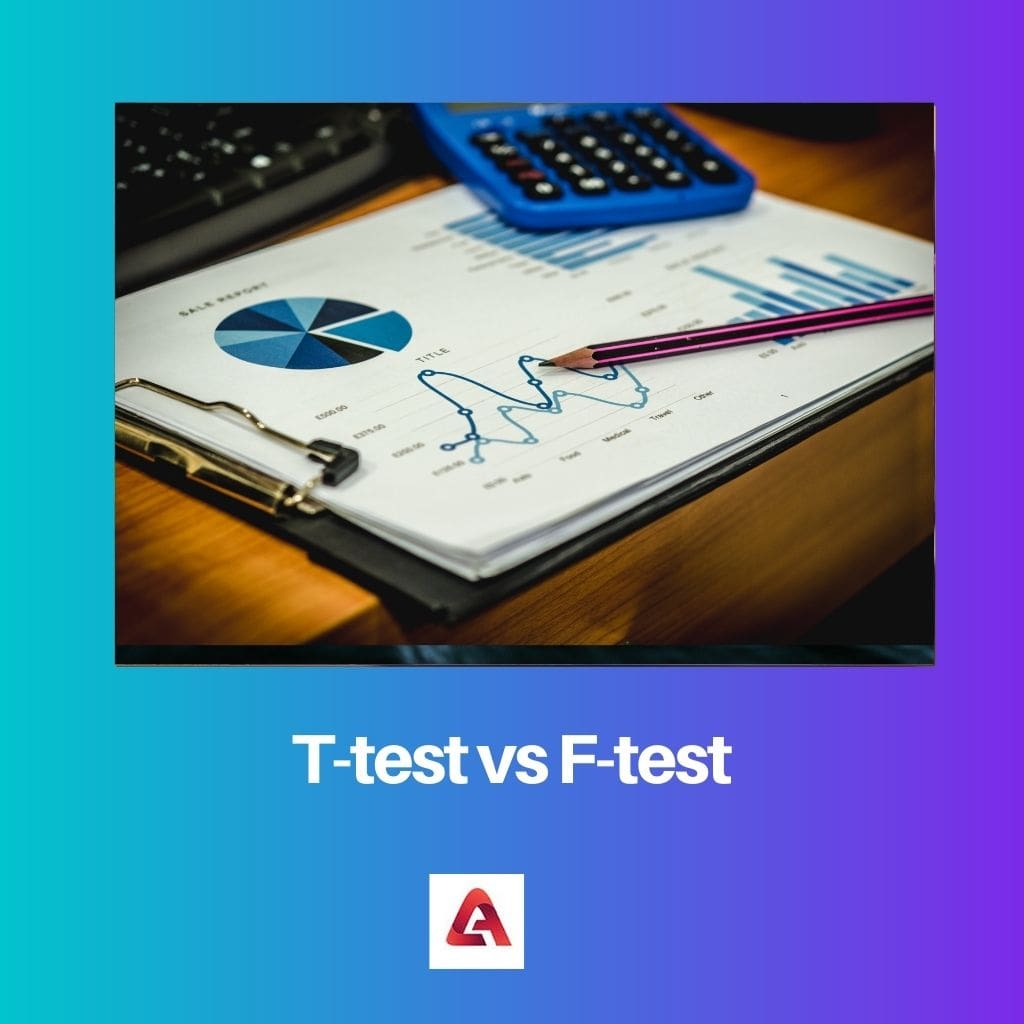A t-test is used to determine if there is a significant difference between the means of two groups, providing a p-value indicating the probability of observing the data if the null hypothesis is true. Conversely, an F-test assesses the equality of variances or the significance of the overall fit of a model by comparing the variances of two or more groups, used in ANOVA or regression analysis, yielding an F-statistic and associated p-value.
Key Takeaways
- A t-test determines if two sets of data are significantly different.
- An F-test determines if two sets of data have the same variance.
- T-test is used for smaller sample sizes, while F-test is used for larger ones.
T-test vs F-test
Two data sets can be tested through a t-test. This test is done to check the difference between the given mean and sample mean. There can be different types of t-tests. F-test can be done to check the difference between two standard deviations. Standard deviations of two samples is compared in f-test.

Comparison Table
| Feature | T-test | F-test |
|---|---|---|
| Purpose | Compares the means of two populations or groups | Compares the variances of two or more populations or groups |
| Number of Groups | Compares two groups | Compares two or more groups (used for three or more groups) |
| Assumptions | Assumes homogeneity of variances (equal variances) for paired t-tests and independence of observations | Assumes normality of data and homogeneity of variances for all groups being compared |
| Output | T-statistic and p-value | F-statistic and p-value |
| Interpretation of p-value | If p-value is less than the significance level (e.g., 0.05), we reject the null hypothesis (no difference in means for t-test, equal variances for F-test) and conclude that the means or variances are statistically different. | |
| Types | Paired t-test: compares means of paired data (same individuals/samples measured twice) | One-way ANOVA (Analysis of Variance): compares means of independent groups |
| Applications | – Comparing the effectiveness of two treatments on the same group before and after. – Comparing the average height of males and females. | – Comparing the variances of exam scores in different classes. – Determining if there are significant differences in crop yield across different fertilizer types. |
What is T-test?
Introduction:
The t-test is a statistical method used to determine if there is a significant difference between the means of two groups. It’s a parametric test, assuming that the data is normally distributed and that the variance is approximately equal between the groups. The t-test is widely employed in various fields, including psychology, biology, medicine, and economics, to compare means and draw conclusions about population parameters.
Hypotheses:
In a t-test, the null hypothesis (H0) states that there is no significant difference between the means of the two groups being compared. The alternative hypothesis (H1), on the other hand, asserts that there is a significant difference between the means.
Types of T-Tests
: There are different types of t-tests depending on the characteristics of the data and the research question being addressed. The most common types include:
- Independent Samples T-Test: This test compares the means of two independent groups to determine if they are significantly different from each other.
- Paired Samples T-Test: Also known as a dependent samples t-test, this test compares the means of two related groups, such as pre-test and post-test measurements from the same individuals.
- One-Sample T-Test: This test assesses whether the mean of a single sample is significantly different from a known or hypothesized population mean.
Assumptions:
Before conducting a t-test, it’s crucial to ensure that the following assumptions are met:
- Normality: The data within each group should follow a normal distribution.
- Independence: Observations within each group should be independent of each other.
- Homogeneity of Variance: The variance within each group should be approximately equal.
Interpretation:
After performing a t-test, the results include a t-statistic and a p-value. The t-statistic indicates the magnitude of the difference between the sample means relative to the variability in the data, while the p-value indicates the probability of observing such an extreme difference if the null hypothesis is true. If the p-value is below a predetermined significance level (0.05), the null hypothesis is rejected, suggesting that there is a significant difference between the means of the two groups.

What is F-test?
Introduction:
The F-test, named after its inventor Sir Ronald A. Fisher, is a statistical method used to compare the variances of two or more groups or to assess the significance of the overall fit of a regression model. It is commonly employed in analysis of variance (ANOVA) and regression analysis to determine if there are significant differences between group means or if the model as a whole explains a significant proportion of the variance in the data.
Hypotheses:
In an F-test, the null hypothesis (H0) states that there is no significant difference between the variances of the groups being compared (for variance comparison) or that the regression model does not explain a significant portion of the variance in the dependent variable (for regression analysis). The alternative hypothesis (H1) asserts that there are significant differences between variances or that the model does explain a significant portion of the variance.
Types of F-Tests:
There are different types of F-tests depending on the context in which they are used:
- F-Test for Equality of Variances: This test compares the variances of two or more groups to determine if they are significantly different from each other. It is used as a preliminary test before conducting other analyses, such as t-tests or ANOVA, to ensure the validity of assumptions.
- F-Test in ANOVA: Analysis of variance (ANOVA) utilizes the F-test to assess whether there are significant differences in means across multiple groups. It compares the variability between group means to the variability within groups, providing an F-statistic that indicates whether the observed differences are statistically significant.
- F-Test in Regression Analysis: In regression analysis, the F-test is used to evaluate the overall significance of the regression model. It assesses whether the independent variables collectively have a significant effect on the dependent variable by comparing the variability explained by the model to the unexplained variability.
Assumptions:
Before conducting an F-test, it is important to ensure that the following assumptions are met:
- Independence: Observations within each group should be independent of each other.
- Normality: The residuals (errors) of the regression model should be normally distributed.
- Homoscedasticity: The variance of the residuals should be constant across all levels of the independent variables.
Interpretation:
After performing an F-test, the results include an F-statistic and a corresponding p-value. The F-statistic indicates the ratio of the explained variability to the unexplained variability, while the p-value indicates the probability of observing such a large F-statistic if the null hypothesis is true. If the p-value is below a predetermined significance level (0.05), the null hypothesis is rejected, suggesting that there are significant differences in variances (for variance comparison) or that the regression model explains a significant portion of the variance (for regression analysis).

Main Differences Between T-test and F-test
- Purpose:
- T-test: Used to compare the means of two groups or to assess if a single sample mean differs significantly from a population mean.
- F-test: Used to compare variances between two or more groups or to evaluate the overall significance of a regression model.
- Number of Groups:
- T-test: Typically used for comparing means between two groups.
- F-test: Can compare variances between two or more groups or assess the overall significance of a model.
- Output:
- T-test: Provides a t-statistic and a p-value indicating the probability of observing the data if the null hypothesis is true.
- F-test: Provides an F-statistic and a p-value indicating the probability of observing the data if the null hypothesis is true.
- Assumptions:
- T-test: Assumes that the data are normally distributed and that the variance is approximately equal between the groups.
- F-test: Assumes independence of observations, normality of residuals in regression analysis, and homoscedasticity (constant variance) of residuals.
- Applications:
- T-test: Commonly used in various fields such as psychology, biology, medicine, and economics for comparing means.
- F-test: Widely used in analysis of variance (ANOVA) for comparing means across multiple groups and in regression analysis to assess the significance of the model.
- Interpretation:
- T-test: If the p-value is below a predetermined significance level (0.05), the null hypothesis is rejected, indicating a significant difference between means.
- F-test: If the p-value is below a predetermined significance level (0.05), the null hypothesis is rejected, indicating significant differences in variances (for variance comparison) or significant explanatory power of the model (for regression analysis).
The breakdown of the one-sample t-test and two-sample t-test is informative and allows readers to understand the context in which each test is applicable.
Absolutely. Contextualizing the applications of these tests is crucial for their effective implementation.
The explanation of the assumptions for the one-sample t-test and F-test provides a solid understanding of the underlying statistical requirements for these methods.
Indeed, an understanding of these assumptions is pivotal for the proper interpretation of statistical tests.
Definitely, understanding the assumptions is critical for the accurate application of hypothesis testing methods.
I completely agree that students should analyze the data with summary statistics and charts before conducting the hypothesis test. It’s crucial to have a clear understanding of the data before jumping into conclusions.
Absolutely! It’s important to have the full picture of the data to make informed decisions.
The comprehensive overview of t-tests and F-tests offers a clear perspective on their applications and distinctions, ensuring readers can utilize them accurately.
Absolutely, the clarity in this post makes statistical hypothesis testing more approachable for learners.
The information provided here is quite comprehensive and valuable for those looking to understand the significance of t-tests and F-tests. Students need to grasp the concepts before applying them.
Absolutely, a strong understanding of these concepts is essential for accurate statistical analysis.
Definitely, this article serves as a solid foundation for students venturing into statistical hypothesis testing.
The explanation of the assumptions for the one-sample t-test and F-test provides a solid understanding of the underlying statistical requirements for these methods.
Indeed, understanding the assumptions is critical for the accurate application of hypothesis testing methods.
The post presents a clear distinction between t-tests and F-tests, making it easier for readers to differentiate and apply the appropriate statistical method.
The detailed comparison table provided in the article is extremely helpful in understanding the implications and applications of t-tests and F-tests.
Absolutely, having a side-by-side comparison helps in clarifying any potential confusion between the two test types.
Definitely, the clear breakdown of parameters in the comparison table is a great educational tool.
Unfortunately, many students tend to focus solely on hypothesis testing without fully understanding the data. This can lead to misleading results and conclusions.
Agreed. Education should emphasize the importance of comprehensive data analysis methods to avoid erroneous interpretations.
While the post offers valuable insights, it would have been beneficial to include some real-world examples to further illustrate the application of t-tests and F-tests.
I agree, real-world scenarios would enhance the practical understanding of these statistical tests.